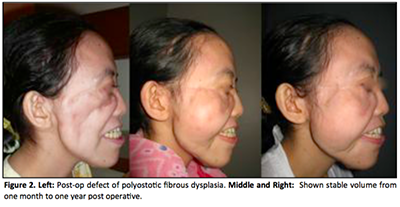Long Term Follow-up of Vascularized Dermal Fat Transfer
DOI:
https://doi.org/10.14228/jpr.v1i6.113Abstract
Backgrounds: Fibrous dysplasia is an uncommon, benign disorder characterized by a tumor-like proliferation of fibro-osseous tissue. It can present as an autosomal dominant disorder affecting the mandible and maxilla bones in children in their teenage years. The patient manifests with unilateral firm swelling of cheek. It can be managed by excision and resulting contour defect that can be managed by reconstructing using vascularized dermal fat. Resorption is the main problem due to an insuf!cient blood supply, and vascularized dermal fat have been described to minimize this problem.
Patients and Methods: In this study we report the results after insertion of vascularized dermal fat into zygomatic-maxilla region. The method consists of implantation of vascularized dermis with attached subcutaneous fat from the antero-lateral thigh (ALT) into the right zygomatic-maxilla region, anastomosing the vascular with temporal superficial vessel. During a one-year follow up, the patient showed good results. Graft atrophy was observed. Despite the more extensive surgery and some minor complications the safety of this method with good functional and cosmetic results makes vascularized dermal fat an excellent alternative to reconstruct facial contour defect.
Results: Compared with free-fat grafts, resorption rates for vascularized adipose tissue transfers are very low. Satisfactory cosmetic results were also achieved.
Summary: The advantages of this method is the minimized resorption and an excellent functional and cosmetic result. Therefor, we imply that vascularized dermal fat is an excellent method to reconstruct facial contour defect.

Downloads
Published
Issue
Section
License

This work is licensed under a Creative Commons Attribution-NonCommercial-NoDerivatives 4.0 International License.
Authors retain the copyright of the article and grant Jurnal Plastik Rekonstruksi the right of first publication with the work simultaneously licensed under a Creative Commons Attribution License. Articles opting for open access will be immediately available and permanently free for everyone to read, download and share from the time of publication. All open access articles are published under the terms of the Creative Commons Attribution-Non-commercial-NoDerivatives (CC BY-NC-ND) which allows readers to disseminate and reuse the article, as well as share and reuse of the scientific material. It does not permit commercial exploitation or the creation of derivative works without specific permission.













